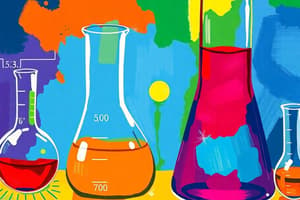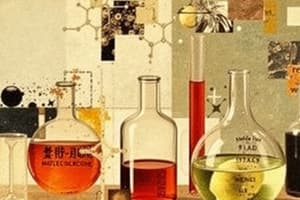Podcast
Questions and Answers
Which of the following best describes the relationship between elements and compounds?
Which of the following best describes the relationship between elements and compounds?
- Elements and compounds are both homogeneous mixtures that can be easily separated.
- Compounds are composed of two or more elements chemically combined in fixed proportions. (correct)
- Elements are composed of compounds, which can be broken down into simpler substances.
- Elements and compounds are interchangeable terms describing any pure substance.
A student measures the volume of a liquid as 25.50 mL. Which of the following statements about the significant figures in this measurement is correct?
A student measures the volume of a liquid as 25.50 mL. Which of the following statements about the significant figures in this measurement is correct?
- The measurement has two significant figures.
- The measurement has four significant figures. (correct)
- The measurement has three significant figures.
- The measurement has five significant figures.
Consider two isotopes of the same element. Which statement is always true?
Consider two isotopes of the same element. Which statement is always true?
- They have the same number of electrons but a different number of protons.
- They have the same number of neutrons but a different number of protons.
- They have the same mass number but a different atomic number.
- They have the same number of protons but a different number of neutrons. (correct)
Which type of chemical bond involves the sharing of electrons between two atoms?
Which type of chemical bond involves the sharing of electrons between two atoms?
What is the molarity of a solution prepared by dissolving 4.0 g of NaOH in enough water to make 500.0 mL of solution? (Molar mass of NaOH = 40.0 g/mol)
What is the molarity of a solution prepared by dissolving 4.0 g of NaOH in enough water to make 500.0 mL of solution? (Molar mass of NaOH = 40.0 g/mol)
Which of the following is true regarding strong acids and bases in aqueous solutions?
Which of the following is true regarding strong acids and bases in aqueous solutions?
A gas occupies 10.0 L at standard temperature and pressure (STP). How many moles of gas are present? (R = 0.0821 L·atm/mol·K)
A gas occupies 10.0 L at standard temperature and pressure (STP). How many moles of gas are present? (R = 0.0821 L·atm/mol·K)
Which of the following statements accurately describes an endothermic chemical reaction?
Which of the following statements accurately describes an endothermic chemical reaction?
Consider the reversible reaction: $A + B
ightleftharpoons C$. At equilibrium, if more of reactant A is added to the system, what will happen according to Le Chatelier's principle?
Consider the reversible reaction: $A + B ightleftharpoons C$. At equilibrium, if more of reactant A is added to the system, what will happen according to Le Chatelier's principle?
Which factor does not typically affect the rate of a chemical reaction?
Which factor does not typically affect the rate of a chemical reaction?
Flashcards
What is matter?
What is matter?
Anything that has mass and takes up space.
What is a pure substance?
What is a pure substance?
A substance with a fixed composition and distinct properties.
What are elements?
What are elements?
Substances that cannot be broken down into simpler substances by chemical means.
What is a homogeneous mixture?
What is a homogeneous mixture?
Signup and view all the flashcards
What are physical properties?
What are physical properties?
Signup and view all the flashcards
What are chemical properties?
What are chemical properties?
Signup and view all the flashcards
What are intensive properties?
What are intensive properties?
Signup and view all the flashcards
What is the International System of Units (SI)?
What is the International System of Units (SI)?
Signup and view all the flashcards
What is an atom?
What is an atom?
Signup and view all the flashcards
What is atomic number (Z)?
What is atomic number (Z)?
Signup and view all the flashcards
Study Notes
The provided text is identical to the existing notes. Therefore, there are no updates to be made.
Studying That Suits You
Use AI to generate personalized quizzes and flashcards to suit your learning preferences.



